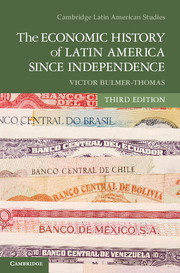Book contents
- Frontmatter
- Dedication
- Contents
- List of Tables, Figures, and Maps
- Preface to the Third Edition
- Preface to the First Edition
- List of Abbreviations
- 1 Latin American Economic Development
- 2 The Struggle for National Identity
- 3 The Export Sector and the World Economy, circa 1850–1914
- 4 Export-Led Growth
- 5 Export-Led Growth and the Nonexport Economy
- 6 The First World War and Its Aftermath
- 7 Policy, Performance, and Structural Change in the 1930s
- 8 War and the New International Economic Order
- 9 Inward-Looking Development in the Postwar Period
- 10 New Trade Strategies and Debt-Led Growth
- 11 Debt, Adjustment, and the Shift to a New Paradigm
- 12 Conclusions
- Appendix 1 Data Sources for Population and Exports before 1914
- Appendix 2 The Ratio of Exports to Gross Domestic Product, the Purchasing Power of Exports, the Net Barter Terms of Trade, and the Volume of Exports, circa 1850 to circa 1912
- Appendix 3 Population, Exports, Public Revenue, and GDP for the Main Latin American Countries before 1914
- Appendix 4 GDP Per Head in Latin America since 1900
- Bibliography
- Index
2 - The Struggle for National Identity
From Independence to Mid-Century
Published online by Cambridge University Press: 05 June 2014
- Frontmatter
- Dedication
- Contents
- List of Tables, Figures, and Maps
- Preface to the Third Edition
- Preface to the First Edition
- List of Abbreviations
- 1 Latin American Economic Development
- 2 The Struggle for National Identity
- 3 The Export Sector and the World Economy, circa 1850–1914
- 4 Export-Led Growth
- 5 Export-Led Growth and the Nonexport Economy
- 6 The First World War and Its Aftermath
- 7 Policy, Performance, and Structural Change in the 1930s
- 8 War and the New International Economic Order
- 9 Inward-Looking Development in the Postwar Period
- 10 New Trade Strategies and Debt-Led Growth
- 11 Debt, Adjustment, and the Shift to a New Paradigm
- 12 Conclusions
- Appendix 1 Data Sources for Population and Exports before 1914
- Appendix 2 The Ratio of Exports to Gross Domestic Product, the Purchasing Power of Exports, the Net Barter Terms of Trade, and the Volume of Exports, circa 1850 to circa 1912
- Appendix 3 Population, Exports, Public Revenue, and GDP for the Main Latin American Countries before 1914
- Appendix 4 GDP Per Head in Latin America since 1900
- Bibliography
- Index
Summary
Independence, which most of Latin America had secured by the early 1820s, came at the end of a long period of economic turmoil and political upheaval during which, it can safely be assumed, living standards fell sharply. From the outbreak of hostilities in 1796 between Great Britain and Spain, Latin America's external trade – imports and exports – was severely disrupted. The invasion of the Iberian Peninsula by Napoleon in 1808 and the imposition of his brother Joseph as king of Spain drove the Portuguese royal family to Brazil and created a temporary alliance between Great Britain and anti-Napoleonic forces in Spain. Exports from Latin America were adversely affected and domestic trade undermined by the flood of imports into Latin America as British merchants searched for an alternative to the blocked continental market.
Napoleon's successful invasion of Spain undermined Spanish authority in Latin America and provided the independence movement – until then weak and inchoate – with the impetus it desperately needed. By the time Napoleon had been finally defeated in 1815, the movement had acquired a dynamic of its own, and the reassertion of Spanish and Portuguese authority over the Iberian Peninsula could not be extended to Latin America. Brazil, a separate kingdom since 1815, refused to recognize the demands of João VI in Lisbon and crowned his son, Dom Pedro, as emperor in 1822. New Spain became Mexico (an empire for nine months under Agustín de Iturbide) and extended briefly to the northern border of Colombia following the annexation of Central America. Spain's South American colonies opted for republican government from the beginning, and by the mid-1820s Spain controlled only Cuba and Puerto Rico. Even Santo Domingo, the eastern part of Hispaniola, had been seized from Spain in 1822 by Haiti, which had gained its independence from France in 1804.
- Type
- Chapter
- Information
- The Economic History of Latin America since Independence , pp. 20 - 49Publisher: Cambridge University PressPrint publication year: 2014

